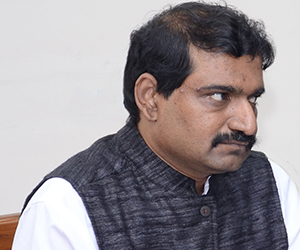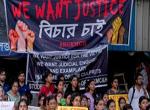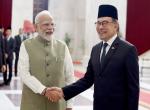The Group of Ministers (GoM), set up to look into the proposed bifurcation of Andhra Pradesh, is expected to submit its report to the Union Cabinet before the winter session of Parliament. The high-powered ministerial panel had detailed discussions over sharing of river water, power, distribution of assets and demarcation of boundaries in its two meetings held early this month.
The GoM will also look into the legal and administrative measures required to ensure that both Telangana and the residuary state of Andhra Pradesh can function efficiently from Hyderabad as the common capital for 10 years.
Earlier, following the cabinet decision to bifurcate the state in pursuance of a Congress Working Committee resolution, Andhra Pradesh was up in flames paralyzing the entire Seemandhra region, bringing even basic services to a grinding halt and in the process causing immense hardship to the people and loss of billions to the exchequer. But for the distraction caused by Cyclone Phailin, the protests would have continued for a longer time.
The demand for Telangana, comprising the Telugu speaking areas of the erstwhile princely state of Hyderabad, has been there right since the time of India’s independence. Though the language of the two regions was the same, a pre-requisite for creation of states on linguistic lines, there was and is very little in common between the peoples of Telangana and other regions of the state namely Rayalaseema and Coastal Andhra.
To begin with, Telangana was never under direct British rule, unlike the Coastal Andhra and Rayalaseema regions of Andhra Pradesh, which were part of British India’s Madras Presidency.
It may be recalled that the States Reorganisation Commission (SRC), appointed in 1953, to study the creation of states on linguistic basis, was not in favour of an immediate merger of Telangana region with Andhra state, despite their common language.
The Commission found that the people of Telangana had several concerns including a less-developed economy than Andhra, but with a larger revenue base, which people of Telangana feared might be diverted for use in Andhra.
In fact, in paragraph 382 of its report, the Commission Report said “opinion in Andhra is overwhelmingly in favour of the larger unit; public opinion in Telangana has still to crystallise itself. Important leaders of public opinion in Andhra themselves seem to appreciate that the unification of Telangana with Andhra, though desirable, should be based on a voluntary and willing association of the people and that it is primarily for the people of Telangana to take a decision about their future”.
The then Prime Minister Pandit Jawaharlal Nehru was initially skeptical of merging Telangana with Andhra State, fearing a “tint of expansionist imperialism” in it. He reportedly compared the merger to a matrimonial alliance having “provisions for divorce” if the partners in the alliance cannot get on well.
Finally, the new state of Andhra Pradesh came into being on November 1, 1956 with assurances to Telangana in terms of power-sharing as well as administrative domicile rules and distribution of expenses of various regions.
However, the honeymoon did not last long with the people of Telangana expressing dissatisfaction over the implementation of the agreements and guarantees, made at the time of the state’s merger.
Following the Jai Andhra agitation in the Seemandhra region in 1973, against the protections (mulki rules) given for Telangana region, the Government of India diluted the guarantees provided in the pre-merger Gentlemen’s agreement, thereby leading to massive agitations across the Telangana regions.
According to proponents of a separate state, Telangana is not only the largest of the three regions of Andhra Pradesh state, covering 41.47% of its total area and inhabited by 40.54% of the state's population but also contributes about 76% of the state's revenues, excluding the contribution of the central government.
They also cite perceived injustices in the distribution of water, budget allocations, and jobs. They allege that Budget allocations to Telangana are generally less than 1/3 of the total Andhra Pradesh budget. There are also allegations that in most years, funds allocated to Telangana were never spent. According to the proponents of separate statehood, only 20% of the total Government employees, less than 10% of employees in the secretariat, and less than 5% of department heads in the Andhra Pradesh government are from Telangana.
Following widespread protests, the UPA Government had announced a five-member committee on Telangana headed by retired Justice B N Srikrishna to look into the issue.
But instead of coming out with a strong recommendation, the Committee, in its report, offered six options ranging from maintaining the status quo to creation of a separate state with the contentious Hyderabad as a Union Territory as also acceptance of the demand for carving out a separate state with Hyderabad as its capital in toto.
Continuing with its dilly dallying tactics, the Centre sat on the recommendations till recently.
Over the years, with an eye on the Telangana voters, almost all political parties have at one point or the other supported the creation of a separate state. Therefore, political parties such as Telugu Desam Party (TDP), whose leader Chandrababu Naidu want on a protest fast against the move, which had favoured the creation of Telangana earlier, are only protesting against the manner in which the ruling UPA had gone about the de-merger. Having kept the issue on the backburner during its decade long rule at the Centre and even reneging on its promise, prompting KCR of Telangana Rashtra Samiti (TRS) to walk out of UPA-1, the Centre had suddenly woken up to the demand ahead of the Lok Sabha elections and announced the creation of the state in a hurry, which clearly smacks of political motives.
United Andhra Pradesh led by the charismatic YSR had contributed much to the formation of UPA-2 and in his absence and following the emergence of Jaganmohan Reddy as a force to reckon with in Seemandhra, the Congress apparently felt it could gain lost grounds by ceding Telangana. With TRS likely to merge with Congress in the new state, party strategists are hoping for Jagan’s homecoming post-polls, thereby retaining its entire base in the region.
Apparently, the biggest loser would be TDP, having lost its base in Telangana and staring a wipe out before the Jagan juggernaut. Therefore, Naidu was forced to sit on a fast while Jagan is trying to encash hard on the anti-Telangana sentiment to consolidate his base.
Apart from the major bone of contention, i.e Hyderabad, there are also key issues such as the status of Government employees, water and power sharing, distribution of assets et al which need to be sorted out ahead of the proposed de-merger. The Centre would have done well to take into confidence all stake holders on both sides of the divide as also regional and national political parties, before taking such a major unilateral decision. In the absence of clarity, the utterances of TRS leaders on contentious issues such as the fate of Government employees is only adding to the anger and confusion among the people. At stake are not just political fortunes but also the fate of millions of citizens, which remains uncertain in the present scenario.
Three states were created during the NDA regime – Uttarakhand, Jharkhand and Chhattisgarh but the process was peaceful with no bitterness between the parent states and the new states. In fact, Bihar virtually lost all its natural resources and Uttar Pradesh its massive revenue from tourism. Yet, there were no complaints. In fact, following the recent Uttarakhand tragedy, it was Uttar Pradesh which announced Rs 25 crore aid, much more than any other state.
The announcement pertaining to Telangana has also once again sparked off a nation wide demand for smaller states and a debate on their viability, with both its advocates and opponents taking extreme stands.
While political parties such as the BJP and BSP are in favour of small states on the grounds that such states are administratively more convenient and give greater say to the local populace in matters of governance, states such as Jharkhand, where independent MLAs like Madhu Kora became Chief Ministers and amassed wealth vastly disproportionate to their income, showed the inherent fragility of polity in the newly carved out utopias often touted as the ultimate panacea for misgovernance and mal-administration in large states.
There are also fears that creation of small states can lead to increased regionalism or parochialism which can fuel separatist sub-national tendencies.
Some of the demands are based purely on irredentist claims. For example, the demand for Gorkhaland on ethno-linguistic grounds. A look into the history would reveal that in the late 18th century, Darjeeling was part of the Sikkim Chogyal’s territory, which was overrun by the Gorkhas of Nepal at the beginning of the 19th century. Following the Anglo-Gorkha war in 1814, Nepal had to cede all the territories annexed by the Gorkhas from the Chogyal, who subsequently gave it to the British East India Company. The question is how far do we go into history?
Going by that logic, perhaps some decades later, illegal Bangladeshi immigrants settled in Assam and elsewhere in the country can seek separate statehood.
As for language, dialect and cultural issues, there cannot ever be an end to such demands. From Bodoland to Karbi-Anglong, Assam is up for grabs. Kumaonis and Garhwalis in Uttarakhand too are different in terms of language and culture though there is no such demand till now. By conceding to such demands, will we be undoing the Herculean efforts made by Sardar Patel to integrate the country into a single entity?
Even as many political and militant groups in Nagaland have been demanding creation of a Greater Nagaland or Nagalim including Naga inhabited areas of Assam, Arunachal Pradesh and Manipur, four districts of eastern Nagaland — Tuensang, Mon, Longleng and Kiphire — have placed a demand for a separate state citing neglect by the "stronger Naga tribes".
With 28 states alone, India has so many regional parties that fractured verdicts and consequent instability have become an integral part of polity, both at the Centre and the states. A dozen more states going by the demands, including those made by letterhead organizations with no ground support, would mean scores of regional parties and thereby more blackmail, more fractured mandates and a more fragmented polity. Will it ultimately lead to the balkanization of India?
Though some of the demands including for Gorkhaland are not new, many have emerged over the last few decades, which witnessed the Central Government increasingly becoming weaker and heavily dependent on the regional parties for their very survival. Does this augur well for the country is the million dollar question?
On the other hand, larger states also pose several challenges. Notwithstanding the fact that the UPA has been reduced to a minority, they are surviving just on the support of two mutually antagonistic parties from a single state. Thus, with their brute Parliamentary strength, large states can determine not only the fate of Governments at the Centre but also influence policies. Smaller states including those in the North East are victims of neglect to a great extent due to their poor presence in the Parliament.
Even the most bitter opponent of the Central Government in small states like Chhattisgarh or Goa would not think of daring the Centre to withdraw all its civil servants from their state, as has been done by the SP Government in Uttar Pradesh.
Smaller states created by the NDA Government including Chhattisgarh and Uttarakhand have done comparatively well in contrast to their situation as part of Madhya Pradesh and UP respectively.
The smaller the states, the lesser would be their monopolistic or hegemonistic tendencies and political clout as is the case with larger states. Moreover, all states would be equal partners in progress.
As for Telangana, the proposed bifurcation of Andhra Pradesh is more of a ‘de-merger’ than the creation of a separate state.
If the creation of Bangladesh has busted the myth that people belonging to the same religion constitute a nation, the de-merger of Telangana has proved that language alone cannot be the basis for creation of a separate state, thereby questioning the very linguistic basis on which the states were reorganized in the first place. It is pertinent to ponder over whether it is time to review this basis in view of the demands for statehood coming from across the country.
Both small and large states have their advantages and disadvantages. Therefore, the demand for statehood has to be studied on a case to case basis. Certain parameters such as developmental yardstick, aspirations of the local population, economic and administrative viability and convenience are aspects that have to be factored into before taking a call. Political gains, as is apparent from the UPA decision on Telangana, should not be the guiding factor in such critical decisions. In any case, more states cannot replace decentralisation and devolution of powers to the grassroots as the ultimate guarantor of good governance.
Moreover, irrespective of the size of the states, the need of the hour is undoubtedly a stronger Centre in the wake of threats to national unity and security from internal insurgents and external enemies. It has to be ensured that demands for smaller states do not dilute the powers of the Centre, which would be detrimental to national interests.
Last but not the least, it has to be ensured that while land may be divided for administrative convenience, hearts should not be divided at any cost. Consensus and not confrontation should be the guiding mantra, for at stake is the very unity and integrity of the nation.
Published Date: 25th October 2013, Image source: http://kaw.stb.s-msn.com










Post new comment